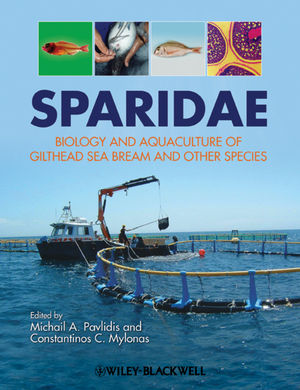Sparidae: Biology and Aquaculture of Gilthead Sea Bream and Other SpeciesISBN: 978-1-4051-9772-4
Hardcover
408 pages
February 2011, Wiley-Blackwell
 |
||||||
Chapter 1 Current status of Sparidae aquaculture (Bernardo Basurco, Alessandro Lovatelli, and Benjamin Garcıa).
1.1 Introduction.
1.2 World Sparidae production.
1.3 Aquaculture status of Atlantic-Mediterranean species.
1.4 Aquaculture status of Indo-Pacific species.
References.
Chapter 2 Phylogeny, evolution and taxonomy of sparids with some notes on their ecology and biology (Reinhold Hanel and Costas S. Tsigenopoulos).
2.1 The position of the Sparidae in the fish tree of life.
2.2 Fossil record.
2.3 The monophyly of the Sparidae.
2.4 Intrafamiliar relationships.
2.5 Larval taxonomy and systematics.
2.6 Biogeography.
2.7 Biology.
2.8 Conclusions.
Acknowledgments.
References.
Chapter 3 Stress and welfare in sparid fishes (Lluis Tort, Michail A. Pavlidis, and Norman Y.S Woo).
3.1 Introduction.
3.2 Fish stress and fish welfare.
3.3 The physiology of the stress response.
3.4 Stress indicators.
3.5 Responses to stressors in sparids.
3.6 Aquaculture and fish welfare.
3.7 Prospects of welfare research in aquaculture.
3.8 Conclusions.
References.
Chapter 4 Reproduction and broodstock management (Constantinos C. Mylonas, Yonathan Zohar, Ned Pankhurst, and Hirohiko Kagawa).
4.1 Introduction.
4.2 Hermaphroditism and puberty in Sparidae.
4.3 Reproductive cycles in Sparidae.
4.4 Reproductive behavior and spawning in Sparidae.
4.5 Broodstock management in Sparidae.
4.6 Hormonal manipulation of reproduction in Sparidae.
References.
Chapter 5 Early development and metabolism (Manuel Yúfera, Luis E.C. Conceição, Stephen Battaglene, Hiroshi Fushimi, and Tomonari Kotani).
5.1 Introduction.
5.2 Anatomical development, general characteristics, and sensory organs.
5.3 Organogenesis and functionality of digestive system.
5.4 Growth and energetics.
5.5 Larval nutrition.
5.6 Feeding.
5.7 Conclusion.
Acknowledgments References.
Chapter 6 Production systems (Noam Mozes, Nikos Papandroulakis, Jose Manuel Vergara, Amal Biswas, Kenji Takii and Andreas Ntatsopoulos).
6.1 Introduction.
6.2 Hatchery and nursery for fingerlings production.
6.3 Cage culture growout technologies.
6.4 Land-based production systems.
6.5 Ongrowing metabolic rates.
6.6 Water quality requirements and environmental conditions.
6.7 Environmental aspects of production systems.
6.8 Summary and future directions References.
Chapter 7 Nutrition and feeding of Sparidae (Aires Oliva Teles, Ingrid Lupatsch, and Ioannis Nengas).
7.1 Introduction.
7.2 Nutritional requirements of juveniles: protein and amino acids.
7.3 Energy and protein requirements in gilthead sea bream—factorial approach.
7.4 Lipids.
7.5 Carbohydrates.
7.6 Vitamins
7.7 Minerals.
7.8 Alternative dietary protein and lipid sources.
7.9 Final considerations References.
Chapter 8 Skeletal deformities and juvenile quality (Clara Boglione and Corrado Costa).
8.1 Introduction.
8.2 Morpho-functional ontogenesis in Sparidae.
8.3 Skeletal deformities in reared Sparidae.
8.4 Other developmental anomalies.
8.5 Effects of deformities on fish performance and quality
8.6 Causative factors of skeletal deformities.
8.7 Discussion and conclusions
References.
Chapter 9 Pigmentation physiology and discoloration problems (Michail A. Pavlidis, Stavros Chatzifotis, and Kohsuke Adachi).
9.1 Introduction.
9.2 Basis of skin color.
9.3 Biochemistry of melanin and carotenoids
9.4 Morphological and physiological skin color changes.
9.5 Regulation of skin color.
9.6 Improvement of skin color in intensively reared Sparidae.
9.7 Conclusions References.
Chapter 10 Diseases and health management (Angelo Colorni and Francesc Padros).
10.1 Viral diseases.
10.2 Bacterial diseases.
10.3 Fungal diseases.
10.4 Parasites and parasitic diseases.
10.5 Non infectious diseases and multifactorial diseases.
References.
Chapter 11 Genomic–proteomic research in Sparidae and its application to genetic improvement (Deborah M. Power, Bruno Louro, Ross Houston, Liliana Anjos, and João C.R. Cardoso).
11.1 Introduction.
11.2 Selective breeding, quantitative trait, loci identification, and application.
11.3 Genomic research.
11.4 Proteomic research.
11.5 Conclusions and future perspectives Acknowledgments References
Index.
Color plates.



